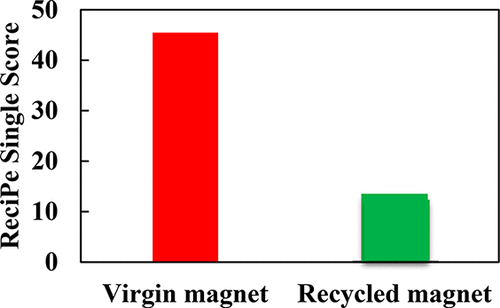当前位置:
X-MOL 学术
›
Environ. Sci. Technol.
›
论文详情
Our official English website, www.x-mol.net, welcomes your
feedback! (Note: you will need to create a separate account there.)
Life Cycle Assessment of Neodymium-Iron-Boron Magnet-to-Magnet Recycling for Electric Vehicle Motors
Environmental Science & Technology ( IF 10.8 ) Pub Date : 2018-03-09 00:00:00 , DOI: 10.1021/acs.est.7b05442 Hongyue Jin 1 , Peter Afiuny 2 , Stephen Dove 2 , Gojmir Furlan 2 , Miha Zakotnik 2 , Yuehwern Yih 1 , John W. Sutherland 3
Environmental Science & Technology ( IF 10.8 ) Pub Date : 2018-03-09 00:00:00 , DOI: 10.1021/acs.est.7b05442 Hongyue Jin 1 , Peter Afiuny 2 , Stephen Dove 2 , Gojmir Furlan 2 , Miha Zakotnik 2 , Yuehwern Yih 1 , John W. Sutherland 3
Affiliation

|
Neodymium-iron-boron (NdFeB) magnets offer the strongest magnetic field per unit volume, and thus, are widely used in clean energy applications such as electric vehicle motors. However, rare earth elements (REEs), which are the key materials for creating NdFeB magnets, have been subject to significant supply uncertainty in the past decade. NdFeB magnet-to-magnet recycling has recently emerged as a promising strategy to mitigate this supply risk. This paper assesses the environmental footprint of NdFeB magnet-to-magnet recycling by directly measuring the environmental inputs and outputs from relevant industries and compares the results with production from “virgin” materials, using life cycle assessments. It was found that magnet-to-magnet recycling lowers environmental impacts by 64–96%, depending on the specific impact categories under investigation. With magnet-to-magnet recycling, key processes that contribute 77–95% of the total impacts were identified to be (1) hydrogen mixing and milling (13–52%), (2) sintering and annealing (6–24%), and (3) electroplating (6–75%). The inputs from industrial sphere that play key roles in creating these impacts were electricity (24–93% of the total impact) and nickel (5–75%) for coating. Therefore, alternative energy sources such as wind and hydroelectric power are suggested to further reduce the overall environmental footprint of NdFeB magnet-to-magnet recycling.
中文翻译:

电动汽车钕铁硼磁铁到磁铁回收的生命周期评估
钕铁硼(NdFeB)磁体每单位体积提供最强的磁场,因此被广泛用于清洁能源应用中,例如电动汽车电机。但是,稀土元素(REEs)是制造NdFeB磁体的关键材料,在过去的十年中一直存在很大的供应不确定性。NdFeB磁铁到磁铁的回收最近已成为减轻这种供应风险的一种有前途的策略。本文通过直接测量相关行业的环境投入和产出来评估NdFeB磁体到磁体回收的环境足迹,并使用生命周期评估将结果与“原始”材料的生产进行比较。研究发现,磁铁对磁铁的回收可将环境影响降低64–96%,取决于所调查的具体影响类别。通过磁铁到磁铁的回收,确定了占总影响77-95%的关键过程是(1)氢混合和研磨(13-52%),(2)烧结和退火(6-24%) ,以及(3)电镀(6-75%)。在产生这些影响中起关键作用的工业领域的投入是电力(占总影响的24-93%)和镍(5-75%)用于涂层。因此,建议使用替代能源,例如风能和水力发电,以进一步减少NdFeB磁体到磁体回收的总体环境足迹。在产生这些影响中起关键作用的工业领域的投入是电力(占总影响的24-93%)和镍(5-75%)用于涂层。因此,建议使用替代能源,例如风能和水力发电,以进一步减少NdFeB磁体到磁体回收的总体环境足迹。在产生这些影响中起关键作用的工业领域的投入是电力(占总影响的24-93%)和镍(5-75%)用于涂层。因此,建议使用替代能源,例如风能和水力发电,以进一步减少NdFeB磁体到磁体回收的总体环境足迹。
更新日期:2018-03-10
中文翻译:

电动汽车钕铁硼磁铁到磁铁回收的生命周期评估
钕铁硼(NdFeB)磁体每单位体积提供最强的磁场,因此被广泛用于清洁能源应用中,例如电动汽车电机。但是,稀土元素(REEs)是制造NdFeB磁体的关键材料,在过去的十年中一直存在很大的供应不确定性。NdFeB磁铁到磁铁的回收最近已成为减轻这种供应风险的一种有前途的策略。本文通过直接测量相关行业的环境投入和产出来评估NdFeB磁体到磁体回收的环境足迹,并使用生命周期评估将结果与“原始”材料的生产进行比较。研究发现,磁铁对磁铁的回收可将环境影响降低64–96%,取决于所调查的具体影响类别。通过磁铁到磁铁的回收,确定了占总影响77-95%的关键过程是(1)氢混合和研磨(13-52%),(2)烧结和退火(6-24%) ,以及(3)电镀(6-75%)。在产生这些影响中起关键作用的工业领域的投入是电力(占总影响的24-93%)和镍(5-75%)用于涂层。因此,建议使用替代能源,例如风能和水力发电,以进一步减少NdFeB磁体到磁体回收的总体环境足迹。在产生这些影响中起关键作用的工业领域的投入是电力(占总影响的24-93%)和镍(5-75%)用于涂层。因此,建议使用替代能源,例如风能和水力发电,以进一步减少NdFeB磁体到磁体回收的总体环境足迹。在产生这些影响中起关键作用的工业领域的投入是电力(占总影响的24-93%)和镍(5-75%)用于涂层。因此,建议使用替代能源,例如风能和水力发电,以进一步减少NdFeB磁体到磁体回收的总体环境足迹。











































 京公网安备 11010802027423号
京公网安备 11010802027423号